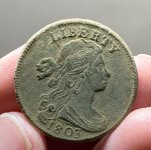Tom_in_CA
Gold Member
- Mar 23, 2007
- 13,837
- 10,360
- 🥇 Banner finds
- 2
- Detector(s) used
- Explorer II, Compass 77b, Tesoro shadow X2
.....Long before ATV's were prohibited here in the Eastern National Forest by NFS/USDA regulations, they were prohibited by notifications posted at individual Ranger Stations, District Offices and even in specific locations within many of the National Forests here. Well, hundreds if not thousands of ATV's were confiscated from and forfeited by their' owners because they did not heed the notifications.....
Ok. Then what's to stop an md'r from looking to see if detecting is "prohibited by notification of posting" ? And if it's NOT prohibited by notification of posting, then .... what are we talking about ?


 What's wrong with it ?
What's wrong with it ?  And while it may be an "agenda", yet they ARE citing the source rules from actual NFS material.
And while it may be an "agenda", yet they ARE citing the source rules from actual NFS material.






